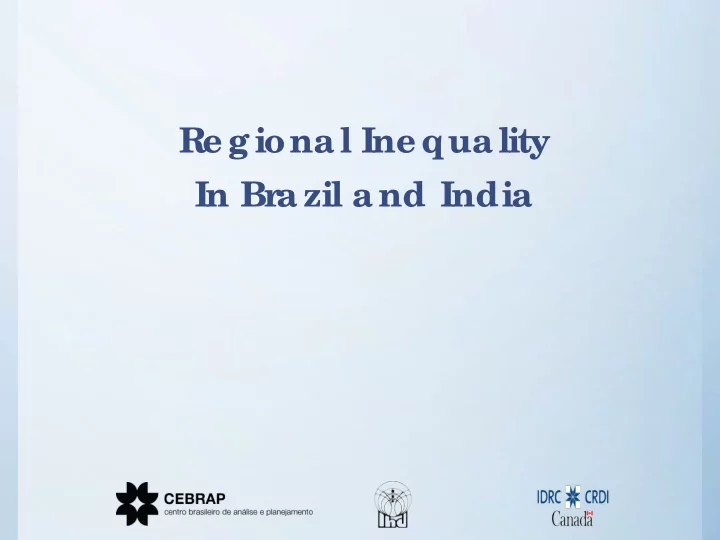

Re g iona l Ine qua lity In Bra zil a nd India
Structure of presentation • 1. Pa tte rns o f re g io na l ine q ua lity in Bra zil a nd I ndia • 2. Cha ng e o ve r time • 3. Re g io na l ine q ua lity a nd the g ro wth re g ime 2
Regional Inequality: Brazil 3
Regional inequality: India 4
Regional inequality – GDP per capita, 2011-12 Net domestic product per capita by region, India, 2010-11 (all-India=100) 160 140 120 100 80 60 40 20 0 Centre Northeast South/West Northwest Kerala 5
Regional inequality – Poverty (%), 2011-12 India, poverty, % of households 2011-12 40 30 20 10 0 Centre Northeast South/West Northwest Kerala 6
Regional inequality – Regular/registered workers (%), 2011-12 India, Regular wage workers (% of all workers, 2011-12) 30 25 20 15 10 5 0 Centre Northeast South/West Northwest Kerala 7
Regional inequality – Casual wages (India); labour income of unregistered workers (Brazil), 2011-12 India, casual wages by region, 2011-12 (all-India = 100) 250 200 150 100 50 0 Centre Northeast South/West Northwest Kerala 8
Change in regional inequality over time •Long term trend in India of growing inequality of per capita output between states after 1980 •This reflects polarizing effects of liberalizing growth and reduced compensatory role of state (NSDP per capita growth since 1993 < 4% in poorer regions, 4.5 to 5.8% in richer regions) •Recently increased integration of the Indian labour market tending to reduce interregional wage differentials for casual labour. But accumulation still concentrated in richer regions •In Brazil regional inequality declining since the 1980s, and especially since 2000. •But inequality within poorer regions remains high in Brazil •Next slides give some of the evidence on this 10
Regional growth rates of NSDP, 1982-83 to 2011-12 10.0 9.0 8.0 7.0 1982-83 to 6.0 1993-94 I ndia 5.0 1993-94 to 4.0 2004-05 3.0 2004-05 to 2.0 2011-12 1.0 0.0 Centre Northeast South and Northwest Kerala West Brazil 11
Changes in wage patterns •.In Brazil, on the whole, wage differences across regions rose in the 1980s and 1990s, but declined after 2005 •In Brazil, decomposition of Theil index of labour income, the contribution of regional differences declined from 10% in 1983 to 6% in 2011 •In India, a complex picture. Per cent contribution of regional differences to overall inequality (Theil index): 1983 1993-94 2004-05 2011-12 Rural regular 4 1 4 5 Rural casual 14 24 28 24 Urban regular 1 0 1 2 Urban casual 7 10 18 14 •So much larger regional contribution to inequality in casual than regular wages. In urban areas, Northwest and Kerala pulling away from others 12
Poverty rates by region, proportion of national average, India 1983 to 2011-12, Brazil 1993-2011 1.60 1.40 1.20 Northeast 1.00 I ndia Centre 0.80 Northwest 0.60 South and West 0.40 Kerala 0.20 0.00 1983 1993-94 2004-05 2004-05 2009-10 2011-12 revised Brazil 13
Regional inequality and the growth regime •Why is regional inequality declining in Brazil and widening in India? •In Brazil, labour market dynamism and a rising and effective national minimum wage. After 2000 benefits of formalization, minimum wage and cash transfers greatest in disadvantaged regions, with impact on growth and incomes •But note growth of inequality within regions in Brazil (role of minimum wage which especially benefits intermediate groups – so the same policy may have regionally differentiated effects) •In India, some reduction in regional wage differentials but unbalanced employment creation because of the concentration of capital in advanced regions (and shift away from wages towards profits, also concentrated). Reduction in wage differentials reflects migration, especially of unskilled workers •Connections between regional inequality and other aspects of inequality (tribal in India, blacks in Brazil). These differentials declining in Brazil but not in India (session in the afternoon). 14
Regional inequality and the growth regime •Regional inequality embedded in the growth regime because of regional variations in the structure of accumulation •Concentration of manufacturing investment (especially FDI) and skilled workforce in SE Brazil and Western/Southern India •Relatively backward regions (NE Brazil, Central India) may serve as labour reserves supplying unskilled labour to accumulation in advanced regions (construction labour, domestic service) •True in Brazil in the past but not today •To some degree true of India today. But India is particularly large and complex. Does India have a single growth regime with regional components or different regimes? •Local factors important – exploitative agrarian systems preventing accumulation and perpetuating inequality local accumulation process (Tamil Nadu different from Gujarat) – Local state differs in effectiveness and orientation – 15
Summing up •Regional inequality reflects growth regime in two ways – Structural inequality between regions within national growth regime – Local forces and institutions with some autonomy creating different regional dynamics •Regional labour markets connected by migration but this is a source of exclusion and discrimination as well as opportunity, not always equalizing •Public sector investment can offset tendency for regional differences to widen. In India the growth in regional inequality coincided with shift from public to private investment. In Brazil recent reduction in inequality connected with regional pattern of public investment •Same forces at work in both Brazil and India at different points in time but India shows greater variety and in recent years more regional concentration. 16
Recommend
More recommend